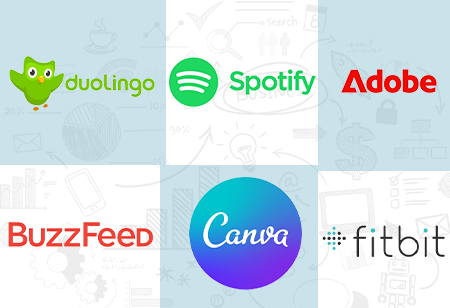Noteworthy Marketing Strategies That Steered Business Growth
In 2025, different companies will grow by utilizing innovative marketing strategies that increase market share, loyalty, engagement, and revenues. The case study showcases the measures that led to the success of business growth for BuzzFeed, Spotify, Canva, Adobe,Fitbit, and Duolingo.
1. BuzzFeed
In 2025, BuzzFeed took its digital marketing to another level by concentrating on user-generated content, algorithm-driven storytelling, and influencer partnerships. It made use of its vast social media reach to promote training content to target audiences derived from their preferences and behaviors.
Key Strategy:
- User-Generated Content: User engagement was the key to BuzzFeed's capability of producing viral content. This involved interactive quizzes, challenges, and polls that users were able to share within their circles. It also took advantage of this by carefully crafting content that invited viral sharing on platforms such as Instagram, TikTok, and YouTube.
- Influencer Collaborations: BuzzFeed collaborated with influencers and celebrities that produced content within BuzzFeed's distinct style. Such collaborations extended the reach of its niche to markets and infused content with authenticity.
- Data-Driven Insights: BuzzFeed applied innovative analytics to inform content production and dissemination. An algorithm used for identifying content categories that could more likely be spread virally served to support targeted content strategy.
Results:
BuzzFeed was able to record a growth of 40% in web traffic with the viral content and increased engagement through influencer marketing. Beyond that, it also saw enormous growth on social media sites and drew not only the ad revenues but consolidated its competitive edge in digital media.
2. Spotify
In 2025, Spotify boosted its digital marketing with personalized content, data-driven recommendations, and influencer partnerships. It used user data to create tailored playlists and podcasts, enhancing engagement. Collaborations with artists and influencers drove cross-promotion and brand authenticity, while algorithm-powered features like Discover Weekly increased content discovery.
Key Strategy:
- Hyper-Personalized Playlists: Spotify's "Discover Weekly" and "Release Radar" features went even more advanced. Utilizing machine learning and AI to scan music listening habits, Spotify was able to predict and generate personalized music playlists per user to maximize the engagement rate and satisfaction level of users.
- Localized Marketing Campaigns: In appreciation of the diversity of its international audience, Spotify's marketing team created localized campaigns. These campaigns emphasized regional music preferences and involved local influencers, which assisted in expanding the brand's presence in foreign markets.
- Interactive Elements: Spotify has added interactive aspects to their system, enabling playlist sharing and interactive branded content access. This form of social feature enhanced the appeal of the content and increased retention of users further.
Results:
Spotify created a personalized content and marketing strategy, hence brightening user engagement that saw average listening time per user go 25% high. And lifted up premium subscriptions further, increasing revenue by 30%.
3. Adobe
The transformation of Adobe’s business model in 2025 from conventional software sales to subscription-based software sales was another important milestone in its product marketing and customer engagement. Retaining customers and growing through value-based content and subscription offerings were the primary focus areas of Adobe's strategy.
Key Strategy:
- Value-Based Content: Adobe emphasized the production of content that illustrated the value of its offerings for both professionals and creative hobbyists. Adobe launched free tutorials, webinars, and workshops, which contributed to a community of enthusiast users.
- Subscription Tiers: Adobe's marketing group launched multiple subscription tiers, serving varying customer segments. These ranged from students, companies, and independent creatives, all with features customized at different price points.
- Cross-Product Integration: The marketing by Adobe highlighted the integration of its software package. By illustrating how products under Creative Cloud could be easily integrated, the firm promoted customers to buy multiple subscriptions.
Results:
Adobe was able to welcome more clients by about 25% in 2025. It saw its recurring revenue increase through an active monthly user increase by 40% across various creative tools. This shift toward subscriptions proved itself a catalyst for the brand's long-term growth in competitive markets.
4. Canva
Canva proved its leadership in the design tool market in 2025 making emphasis on accessibility and creating collaboration opportunities that empowered creativity for individuals and businesses. It has a platform user-friendly interface for all users irrespective of the novice or expert value without exception.
Key Strategy:
- User-Centric Design Tools: The primary strategy for Canva involved its simple interface, making design accessible to anyone, regardless of skill level. AI-based functions offered instant design suggestions for layouts, colors, and text, accelerating the designing process.
- Collaboration Features: Collaborative features were central to the success of Canva, permitting teams, organizations, and institutions to collaborate simultaneously. The platform, which operates in the cloud, facilitated the easy sharing, commenting, and co-creating, enhancing creativity and productivity.
- Community Engagement and Content Creation: Canva involved users through its Design School, with tutorials, templates, and design challenges. The Canva Marketplace enabled users to earn money from their designs, building community and shared creative achievement.
Results:
Canva experienced a 35% increase in active monthly users and an increase in paid subscriptions during 2025, solidifying its position as the leading graphic design software. Its ease of use and collaboration features enabled it to outdo its competitors across industries such as education, marketing, and content creation.
5. Fitbit
Fitbit has made great strides in 2025 within its product line focused on personalization, health integration, and even more community interaction. The company has developed a highly sophisticated technology application to extend the fitness ecosystem into a more integrated approach with wellness for its users.
Key Strategy:
- Personalized Health Insights: Fitbit combined AI and machine learning to deliver hyper-personalized fitness programs and health advice. Stress tracking, sleep monitoring, and mental health tracking added to its emphasis on fitness to provide a complete health experience.
- Integrated Wearables and Advanced Integration: Fitbit wearables had advanced sensors to provide better workout, recovery, and sleep data, integrated with other health apps for an integrated wellness approach.
- Fitness Challenges and Social Interaction: Fitbit increased interaction with challenges, group exercises, and social components, encouraging users to keep moving and build healthy routines in tandem.
Results:
Fitbit experienced a 25% rise in active users in 2025 due to customized health features and group challenges. Its high integration with other fitness apps enhanced user stickiness, ranking it among the best for overall fitness tracking.
6. Duolingo
Duolingo revolutionized the language learning process in 2025 by incorporating gamification, cultural applicability, and social interaction further into its system. It made learning languages more interactive, fun, and accessible, spreading its wings wider.
Key Strategy:
- Gamification of Learning: Duolingo supplemented its gamification with additional challenges, achievements, and interactive features. Tracking of progress, immediate rewards, and daily streaks encouraged users to continue their language learning process.
- Cultural Context and Immersive Content: Another item recently added to Duolingo was culture, such as some facts regarding culture, real-life context, and conversations with native speakers. It helps them get more attuned to the language.
- Social and Collaborative Features: Duolingo introduced a few connecting features for friends, language communities, and competing in assignments in leaderboards- thus bringing in community and engaging people for long term.
Results:
More than 50% of Duolingo's active user base was grown by the year 2025, this has especially been attributed to increased usage by younger populations. It was gamification, cultural immersion, and social elements that drove and bolstered its community, moral to make Duolingo the top most platform for learning languages.
Conclusion
BuzzFeed, Spotify, Canva, Adobe, Fitbit, and Duolingo implemented fresh, data-powered marketing tactics and emphasized personalization to fuel expansion and brand stickiness. Utilizing upcoming innovations and grasping consumer trends allowed them to maintain long-term accomplishment and market share advantage.
🍪 Do you like Cookies?
We use cookies to ensure you get the best experience on our website. Read more...






